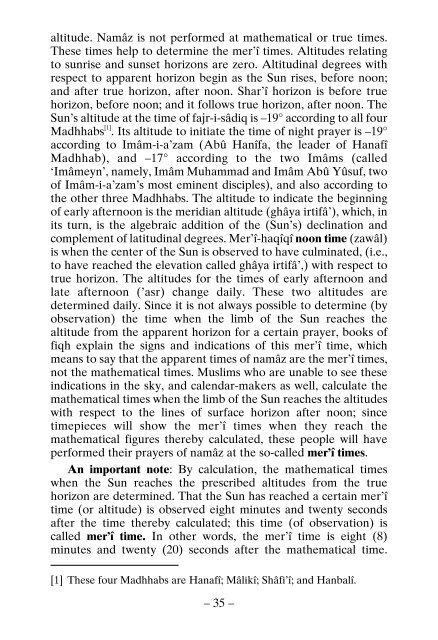O Son !
THE BOOK ‘O SON’ Al-hamdu lillâhi Rabbil ’âlamîn. Wa-s-salâtu wa-s-salâmu ’alâ Rasûlinâ Muhammadin wa Âlihi wa Sahbihi ajma’în. 1– O son! Collecting from books written by the scholars of the Hanafî Madhhab three hundred and sixty hadîth-i-sherîfs and forty-four khabars and also the seven essentials and the five rukns and the seven wâjibs and the fourteen sunnats and the twenty-five mustahabs and the fourteen mufsids of namâz, I have explained them for you. Adapt your acts and deeds to these teachings so that you attain fayz and nejât (salvation)! 2– Also for your information, I have collected a thousand and ninety âdâb (adabs) for you and for other young Muslims like you. If you adapt your actions and acts of worship to these teachings, they will be sufficient for you. If you laze, disobey Allâhu ta’âlâ and cease from these practices and manners, you will be afflicted with slavery and disgrace in the world and subjected to torment in the world to come. If you live up to them and advise your Muslim brothers to do the same, it will be useful for you. They will say blessings over you. And Haqq ta’âlâ will accept their invocations. For, a slave will be pardoned on account of another slave’s invocations for them.
THE BOOK ‘O SON’
Al-hamdu lillâhi Rabbil ’âlamîn. Wa-s-salâtu wa-s-salâmu ’alâ
Rasûlinâ Muhammadin wa Âlihi wa Sahbihi ajma’în.
1– O son! Collecting from books written by the scholars of the
Hanafî Madhhab three hundred and sixty hadîth-i-sherîfs and
forty-four khabars and also the seven essentials and the five rukns
and the seven wâjibs and the fourteen sunnats and the twenty-five
mustahabs and the fourteen mufsids of namâz, I have explained
them for you. Adapt your acts and deeds to these teachings so that
you attain fayz and nejât (salvation)!
2– Also for your information, I have collected a thousand and
ninety âdâb (adabs) for you and for other young Muslims like you.
If you adapt your actions and acts of worship to these teachings,
they will be sufficient for you. If you laze, disobey Allâhu ta’âlâ
and cease from these practices and manners, you will be afflicted
with slavery and disgrace in the world and subjected to torment in
the world to come.
If you live up to them and advise your Muslim brothers to do
the same, it will be useful for you. They will say blessings over you.
And Haqq ta’âlâ will accept their invocations. For, a slave will be
pardoned on account of another slave’s invocations for them.
Create successful ePaper yourself
Turn your PDF publications into a flip-book with our unique Google optimized e-Paper software.
altitude. Namâz is not performed at mathematical or true times.<br />
These times help to determine the mer’î times. Altitudes relating<br />
to sunrise and sunset horizons are zero. Altitudinal degrees with<br />
respect to apparent horizon begin as the Sun rises, before noon;<br />
and after true horizon, after noon. Shar’î horizon is before true<br />
horizon, before noon; and it follows true horizon, after noon. The<br />
Sun’s altitude at the time of fajr-i-sâdiq is –19° according to all four<br />
Madhhabs [1] . Its altitude to initiate the time of night prayer is –19°<br />
according to Imâm-i-a’zam (Abû Hanîfa, the leader of Hanafî<br />
Madhhab), and –17° according to the two Imâms (called<br />
‘Imâmeyn’, namely, Imâm Muhammad and Imâm Abû Yûsuf, two<br />
of Imâm-i-a’zam’s most eminent disciples), and also according to<br />
the other three Madhhabs. The altitude to indicate the beginning<br />
of early afternoon is the meridian altitude (ghâya irtifâ’), which, in<br />
its turn, is the algebraic addition of the (Sun’s) declination and<br />
complement of latitudinal degrees. Mer’î-haqîqî noon time (zawâl)<br />
is when the center of the Sun is observed to have culminated, (i.e.,<br />
to have reached the elevation called ghâya irtifâ’,) with respect to<br />
true horizon. The altitudes for the times of early afternoon and<br />
late afternoon (’asr) change daily. These two altitudes are<br />
determined daily. Since it is not always possible to determine (by<br />
observation) the time when the limb of the Sun reaches the<br />
altitude from the apparent horizon for a certain prayer, books of<br />
fiqh explain the signs and indications of this mer’î time, which<br />
means to say that the apparent times of namâz are the mer’î times,<br />
not the mathematical times. Muslims who are unable to see these<br />
indications in the sky, and calendar-makers as well, calculate the<br />
mathematical times when the limb of the Sun reaches the altitudes<br />
with respect to the lines of surface horizon after noon; since<br />
timepieces will show the mer’î times when they reach the<br />
mathematical figures thereby calculated, these people will have<br />
performed their prayers of namâz at the so-called mer’î times.<br />
An important note: By calculation, the mathematical times<br />
when the Sun reaches the prescribed altitudes from the true<br />
horizon are determined. That the Sun has reached a certain mer’î<br />
time (or altitude) is observed eight minutes and twenty seconds<br />
after the time thereby calculated; this time (of observation) is<br />
called mer’î time. In other words, the mer’î time is eight (8)<br />
minutes and twenty (20) seconds after the mathematical time.<br />
[1] These four Madhhabs are Hanafî; Mâlikî; Shâfi’î; and Hanbalî.<br />
– 35 –

















